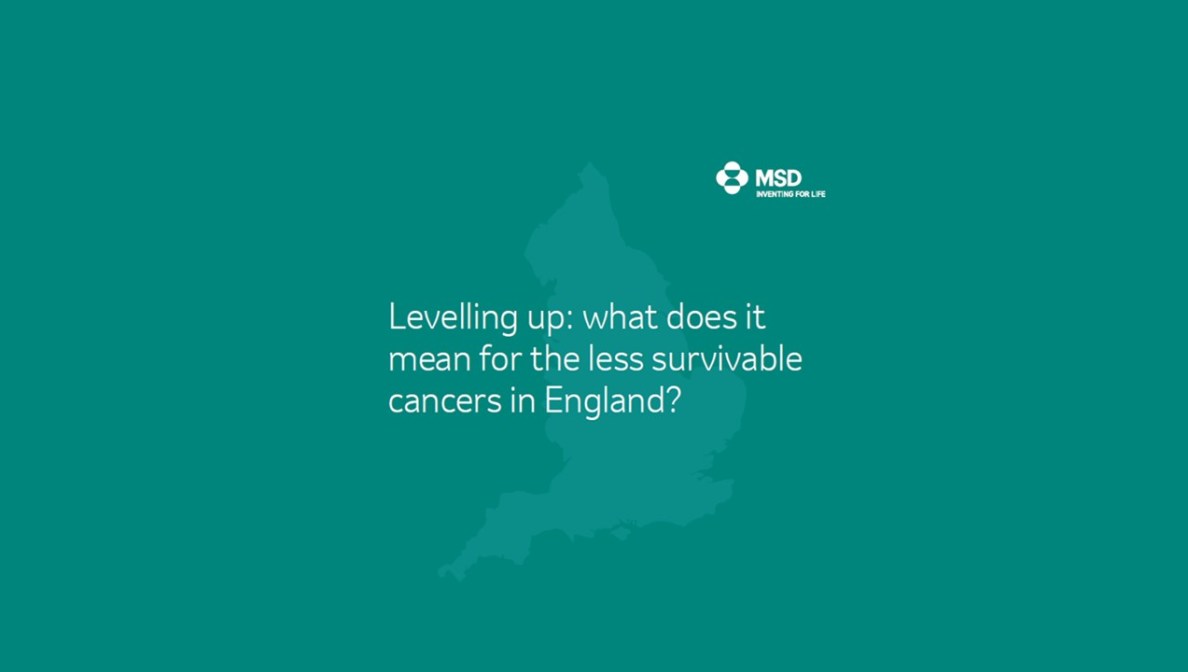MSD publishes key report on inequalities in cancer
October 2022

Levelling up: what does it mean for cancer in England?
Sadly, some cancers are deemed less survivable owing to issues with diagnosis or treatment compared to other cancer types. MSD believes there is an opportunity for the Government to pledge to double survival rates for people with one of these less survivable cancers over the next decade.
Every year, over 90,000 people in the UK are diagnosed with a less survivable cancer: lung cancer, pancreatic cancer, liver cancer, oesophageal cancer, stomach cancer and brain cancer. These cancers make up a quarter of all diagnoses, but more than 40% of all deaths from the disease.1 Survival rates have seen little improvement since the early 1970s,2 with only 16% of patients living beyond five years.3 MSD’s recently published report, developed with input from the Less Survivable Cancers Taskforce, highlights widespread geographical variation in diagnosis, treatment and outcomes for people with a less survivable cancer in England, and a growing body of evidence to suggest that, in some cases, deprivation is a driver of this variation. Rightly, the Government has made numerous commitments to improving cancer outcomes and tackling health inequalities.4, 5 We make the case that without a greater focus on, and investment in, the less survivable cancers, it will not be possible to deliver on the ambitions of the NHS Long Term Plan and it will not be possible to lead the world in cancer care.
Please read the report linked here to view our five key recommendations on how to level up the less survivable cancers and addressing unwarranted variation.
MSD worked with the Less Survivable Cancers Taskforce to conduct research into and develop a report on inequalities in treatment and outcome of less survivable cancers. This report was funded and developed by MSD with advice and input from members of the Less Survivable Cancers Taskforce.
1 Less Survivable Cancers Taskforce calculations using data from: Cancer Research UK. Cancer Statistics for the UK. 2022. Available from https://www.cancerresearchuk.org/health-professional/cancer-statistics-for-the-uk. Accessed August 2022
2 Quaresma, M. et al. 40-year trends in an index of survival for all cancers combined and survival adjusted for age and sex for each cancer in England and Wales, 1971-2011: a population-based study. Lancet. 385(9974):1206-18. 2015. Available at: doi: 10.1016/S0140-6736(14)61396-9
3 Less Survivable Cancers Taskforce calculation using data from: NHS Digital (National Cancer Registration and Analysis Service). Cancer Survival in England, cancers diagnosed 2015 to 2019, followed up to 2020 (Adult cancer survival data tables for 2015-2019 diagnoses). 2022. Available from: https//digital.nhs.uk/data-and-information/publication/statistical/cancer-survival-in-england/cancers-diagnosed-2015-to-2019-followed-upto-2020. Accessed August 2022
4 NHS England. The NHS Long Term Plan. 2019. Available from: https://www.longtermplan.nhs.uk/publication/nhs-long-term-plan/
5 Department for Levelling up, Housing and Communities. Levelling Up the United Kingdom. 2022. Available from: https://www.gov.uk/government/publications/levelling-up-the-united-kingdom
GB-NON-06528 | Date of Preparation: October 2022